There was stillness across the canyon. Even with an expectant crowd gathered, it was quiet enough to hear the river racing 1,200m below my feet as I perched on rocks at Cruz del Condor, a condor hotspot in Peru’s dramatic Colca Canyon. Eyes, binoculars and cameras swept across the landscape, waiting.
There was no sign, but Paul Vica, my local Collagua guide, wasn’t worried. “It’s OK. I have the condors’ cellphone,” he told me. “I can call them and they’ll come.” There’s another way to get them here: “If you have a kilo of donkey meat, now is the time to use it,” Paul joked.
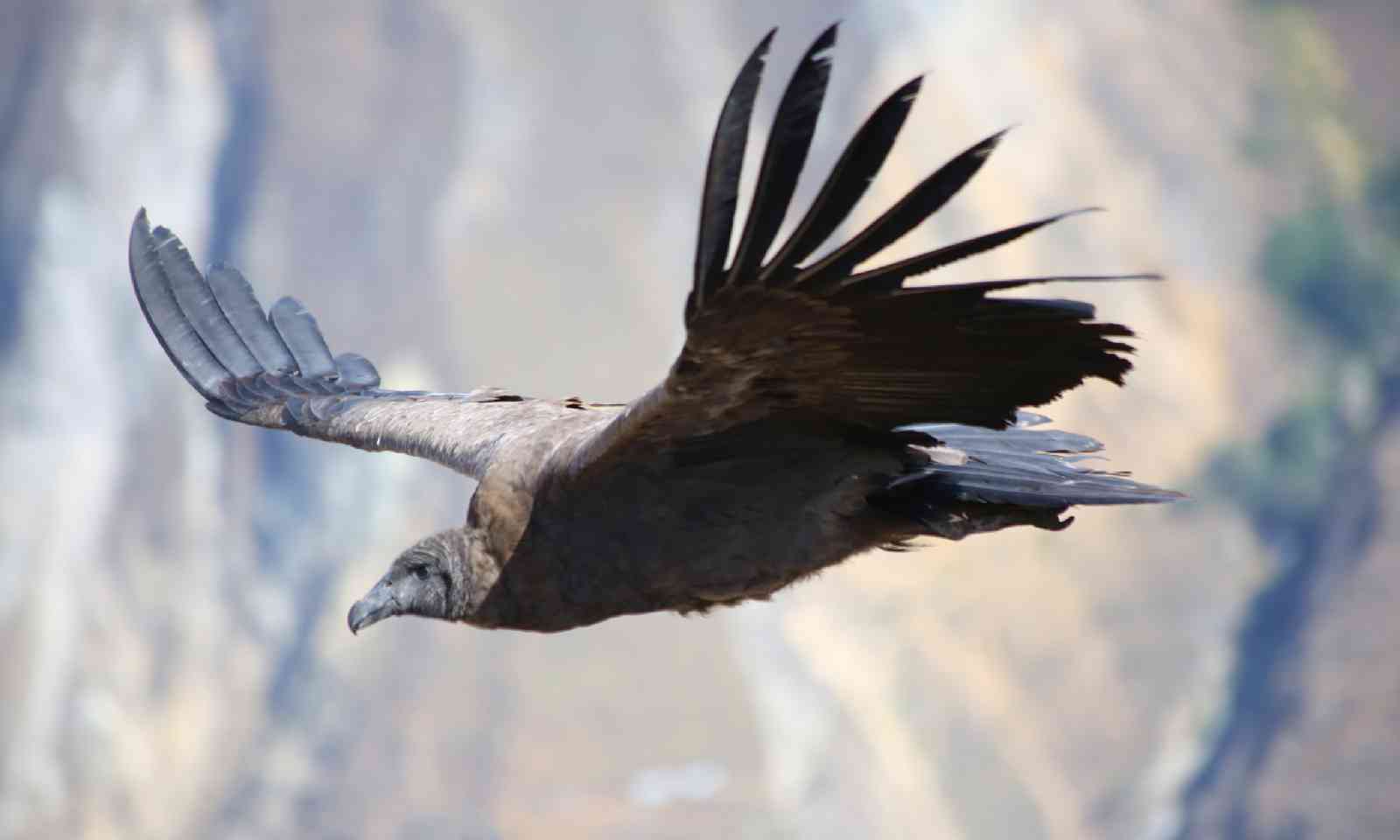
With the moon still high in the sky, sunlight filled the valley, warming the air and luring the birds into action. One after another, the Andean condors became visible, circling far below us in the depths of the canyon. I counted six, all large brown juveniles.
They rose up towards the Cruz del Condor viewpoint, riding on the morning’s thermals. We watched as they glided, turned, dived and climbed, soaring above our heads before gradually making their way down the length of the canyon, disappearing out of sight.
The birds are disappearing on a grander, more worrying scale, too. Currently classified as ‘endangered’, Peru’s condor population is declining. Colca Canyon can already boast of being perhaps the second-deepest canyon in the world (the deepest is allegedly in China), more than twice as deep as the Grand Canyon (3,270m or 4,160m deep, depending on who you ask and where they measure from).
But it’s the condors that put it on the map, which is strange, given there are more of the birds in parts of Argentina and Chile. Peru’s condors are a vital part of Andean culture, though – so much so that in 2015 the country’s government announced a National Strategy to protect, conserve and hopefully increase the numbers of condors across Peru.

There are many superstitions: that a good person could be reborn as a condor; that a condor flying over a village means someone there will soon die. “Condors are a sacred creature,” Paul explained. “The people in this area call the condor the apu, which is like ‘god’. They say the condor is a messenger from the other world, the connection between this life and the other life. I see a condor as an animal. But my parents and grandparents say, look, the apu is flying.”
“People think Arequipa is called the White City because of all the white stone,” local guide Patricia Oviedo told me as we walked around downtown’s alleys and plazas of volcanic white sillar. “The real reason is that after the Spanish arrived here in the 1530s and 1540s, the population was 85% white.”
The city has a few other names: Volcano City and Tremble City (because of earthquakes). “It always shakes,” said Patricia. We passed the Mario Vargas Llosa Library, named after the Arequipa-born Nobel prize-winning author, and made our way to Plaza des Armas, which, with fountains and pigeons, felt like the city’s Trafalgar Square.
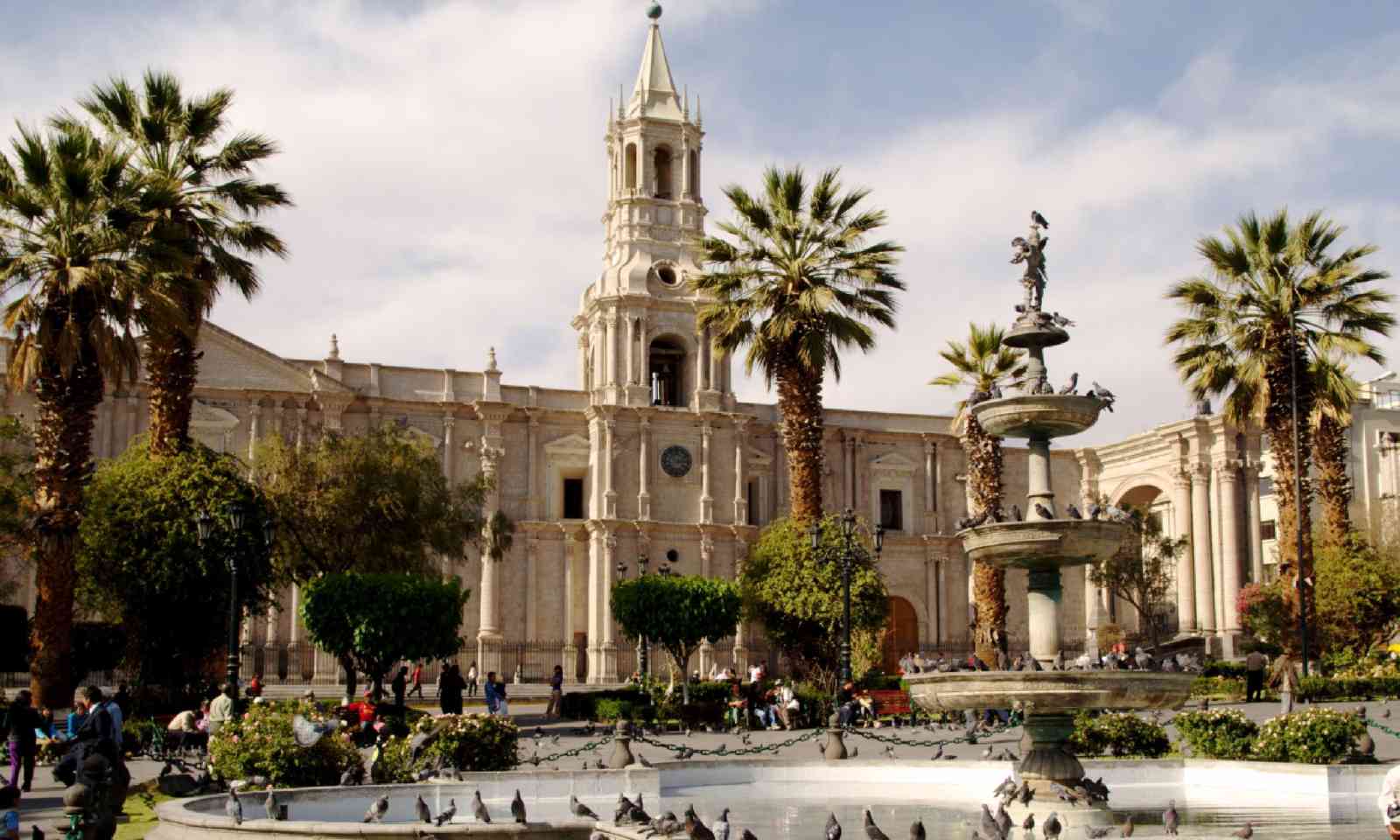
Plaza in Arequipa (Shutterstock)
Patricia pointed to the tower of the basilica, rebuilt after 2001’s big earthquake. “Arequipeños are very proud, very ‘up’. Many times after earthquakes, the city has suffered and we had to rebuild. It’s a very resilient city.”
The city’s most famous resident (Llosa lives in Lima) is Juanita, a frozen mummy, one of four children whose bodies were discovered on the summit of Ampato volcano in Colca Canyon. All were victims of Inca ritual sacrifices to appease the gods or ask for good crops.
I visited Museo Santuarios Andinos where Juanita’s body is held. The museum is an interesting look into ancient Inca culture, with displays of plates and pots for alcoholic chicha and coca, as well as statues and other offerings. But to see Juanita, cased in glass, knowing her skull was fractured by a blow to the head with a ceremonial rock, felt very sad, an example of the brutal things people do in the name of religion.
Further along, a farmer led a troop of llamas along the road, each dressed in bright pink and red ribbons, on their way to a local festival; their faces read ‘mortified’. We could’ve driven right in, but there’s a more fun way to arrive at the Colca Valley.
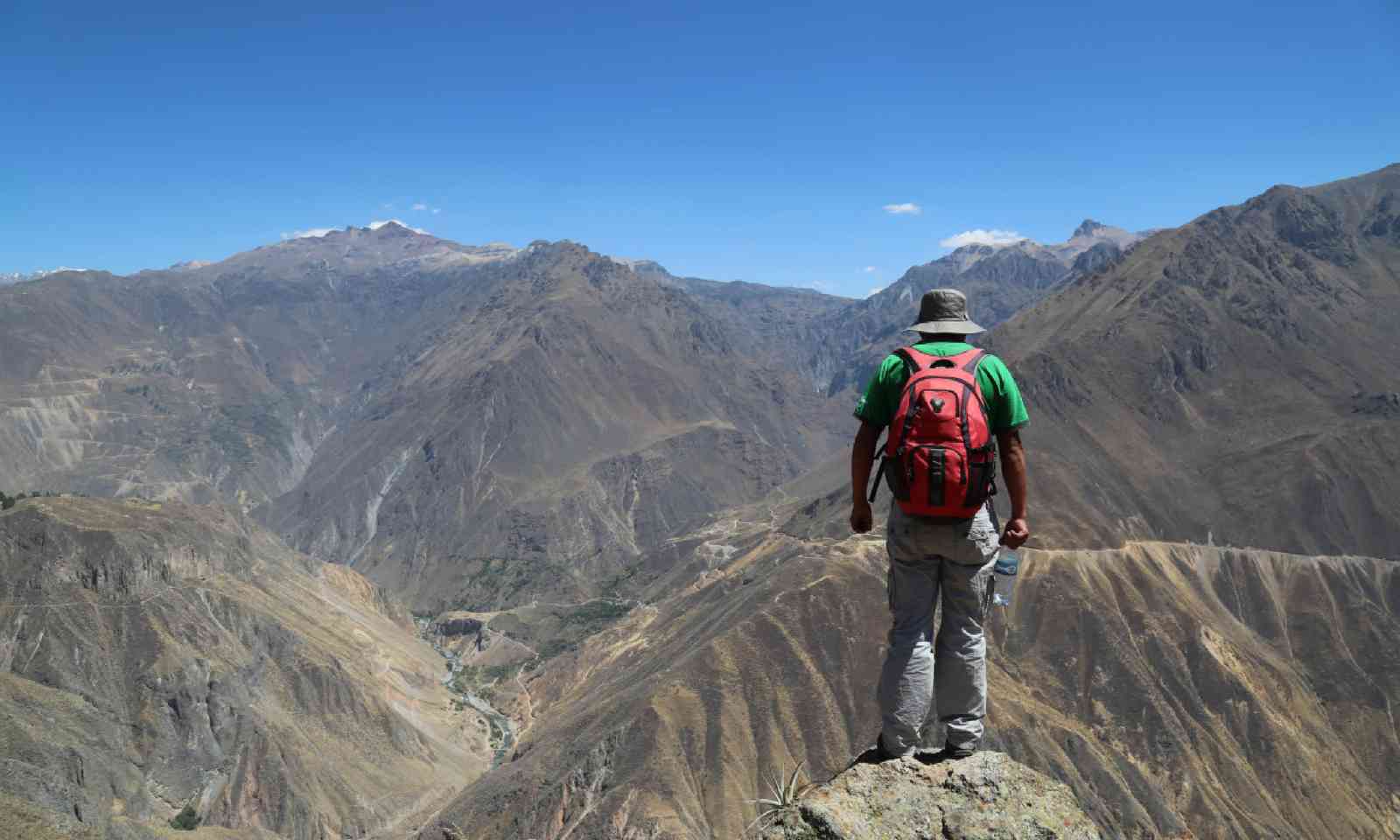
At the road’s 4,910m highpoint, Miradores de los Volcanes, I met Paul to descend instead by mountain bike. We zipped downhill on a zigzagging trail, avoiding (or trying to avoid) rocks and little bushes. Five minutes in, Paul stopped to show me a green plant. “This is chachacoma, to make tea. It’s better than coca for altitude sickness.”
We raced on, clouds casting shadows over the huge valley. Viscachas (like bushy-tailed rabbits) bolted as we rolled by. The trail joined the road and we sped down curves and switchbacks, our 40km ride taking us to the little town of Chivay and across the town square of Yanque, all the way to Colca Lodge and a hot cup of coca tea.
I drove out early next morning with Paul to Cruz del Condor, the pre-Inca (and still used) agricultural terraces of Colca Valley slowly giving way to the sheer granite walls of Colca Canyon. The condors are big business here, tourists spilling out of buses and vans, locals selling food and postcards.
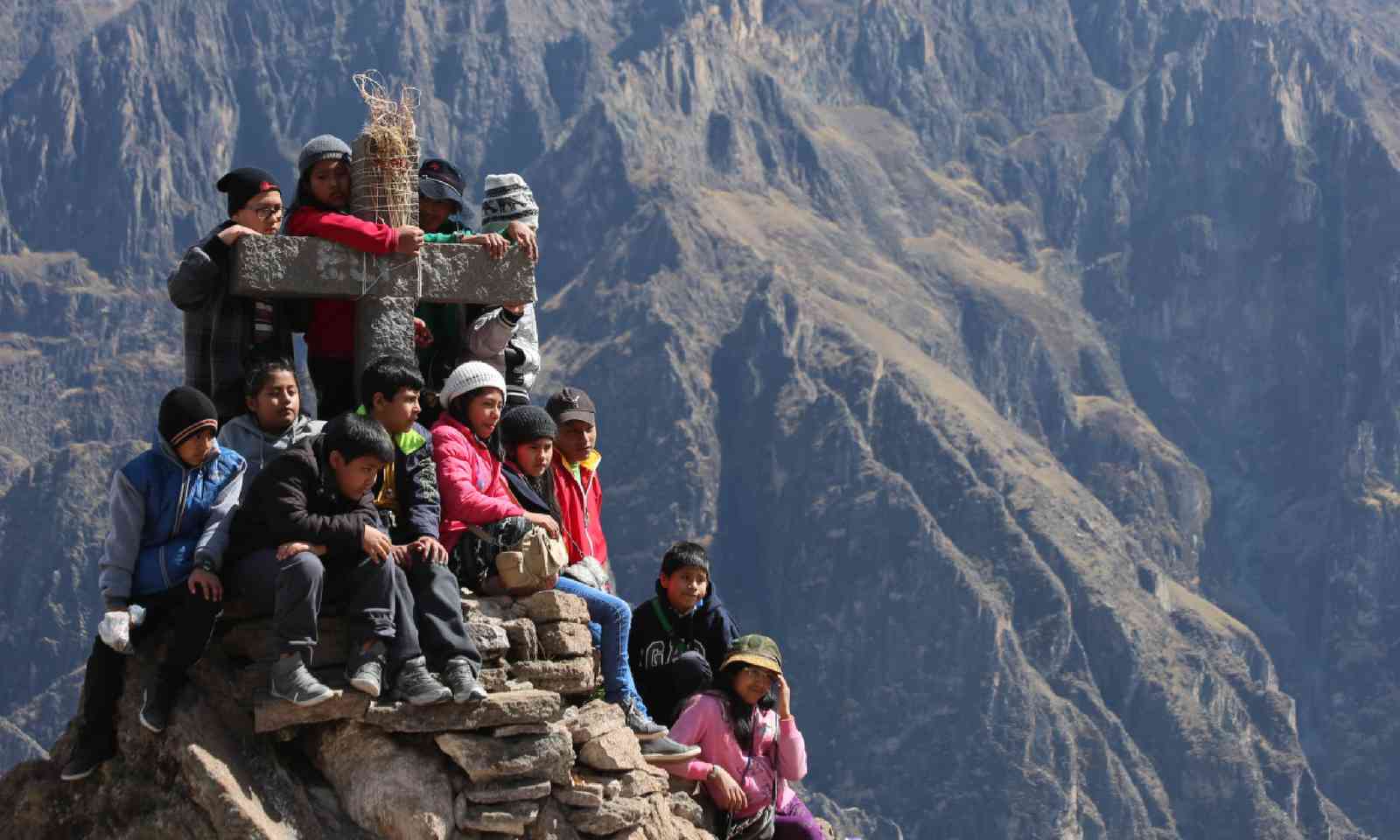
But not everyone likes the birds. “Some people blamed them for killing their animals,” Paul explained, as we sat on the rocks next to the viewpoint’s cross, “so they killed them with pistols.”
There are other likely reasons for the decline, from habitat destruction and urbanisation to the birds swallowing poison intended for other predators such as pumas. There’s also an Andean ritual that continues in some areas, the Yawar Fiesta (Blood Party), which involves a condor (symbolising the indigenous people) being tied to the back of a bull (symbolising the Spanish), the fight representing Latin America’s historic struggle.
Although the condor is supposed to be victorious and escape, it often dies. The National Strategy will look at all of that, but the first step will be a census in Colca Canyon and other condor areas to find out how many condors there are in the country, with the first figures due in 2016.
“We need to know how many condors there are, how many eggs, how many nests,” said Paul, who’s in favour. “My grandfather says 40 to 50 years ago there were many, many condors in this area. It’s important to protect them so we see more again.”
Even with the crowd and their selfie sticks, watching six of the massive birds soar over the canyon was a powerful experience. One of the world’s heaviest birds, with a wingspan of up to 3.2m, they’re strong but graceful in the air. They crossed in front of the sun and glided over the still-visible moon, before making their way into the warmer, deeper parts of the canyon to search for food.

Condors are a safe bet around the cross. “There are seven nests in the cliffs around the Cruz,” Paul informed me. But there’s another reason they might like it here: I heard multiple reports that animal carcasses are put out across the canyon to keep the birds coming and ensure the survival of the valuable tourist trade, which could be disrupting the birds’ natural behaviour.
As a condor expert I met in Arequipa put it: “Artificial feeding is good for tourists and local businesses, but bad for the environment and for condors.” This might be something looked at as part of the National Strategy. Change could be coming to Cruz del Condor.
Up ahead I could see the snowy peaks of Hualca Hualca and active Sabancaya volcano spewing smoke into the sky. Behind Sabancaya, partially visible, was Ampato, where Juanita’s remains were discovered. Hiking on through fields of tall grass, I came out at a waterfall, the water flowing down from Mismi mountain, the source of the Amazon.

Hiking to the source of the Amazon River (Shutterstock)
It was there that I headed early next morning. Seeing the source of the Amazon River was the draw, but the colourful mountain landscapes and wildlife along the way made the drive. Flamingos stalked small lagoons, alpacas grazed and little grouse-like tinamou scuttled off the road.
“Acclimatisation stop,” Paul announced, as we got out next to a lake busy with ducks, Andean geese and puna ibis.
We drove higher, spotting vicuñas running across a sun-baked plateau, before parking below Mismi’s 5,597m summit. There was snow on the ground; the air was cold and supermodel thin. Paul brewed chachacoma tea, then we hiked around the rocky curve of the mountain.
“This is the official spot, Carhuasanta, the source of the Amazon,” Paul said, pointing at water gushing from cracks in the cliff face. I couldn’t resist filling my bottle and taking a good glug of ‘Amazon source’. There’s a debate here, some saying the Amazon starts in other locations around Mismi or further afield. But for now, this spot has the official sign.
“You can say the longest river in the world starts from Mismi,” Paul told me proudly. “It flows from here, 6,800km, all the way to the Atlantic Ocean in northern Brazil.”
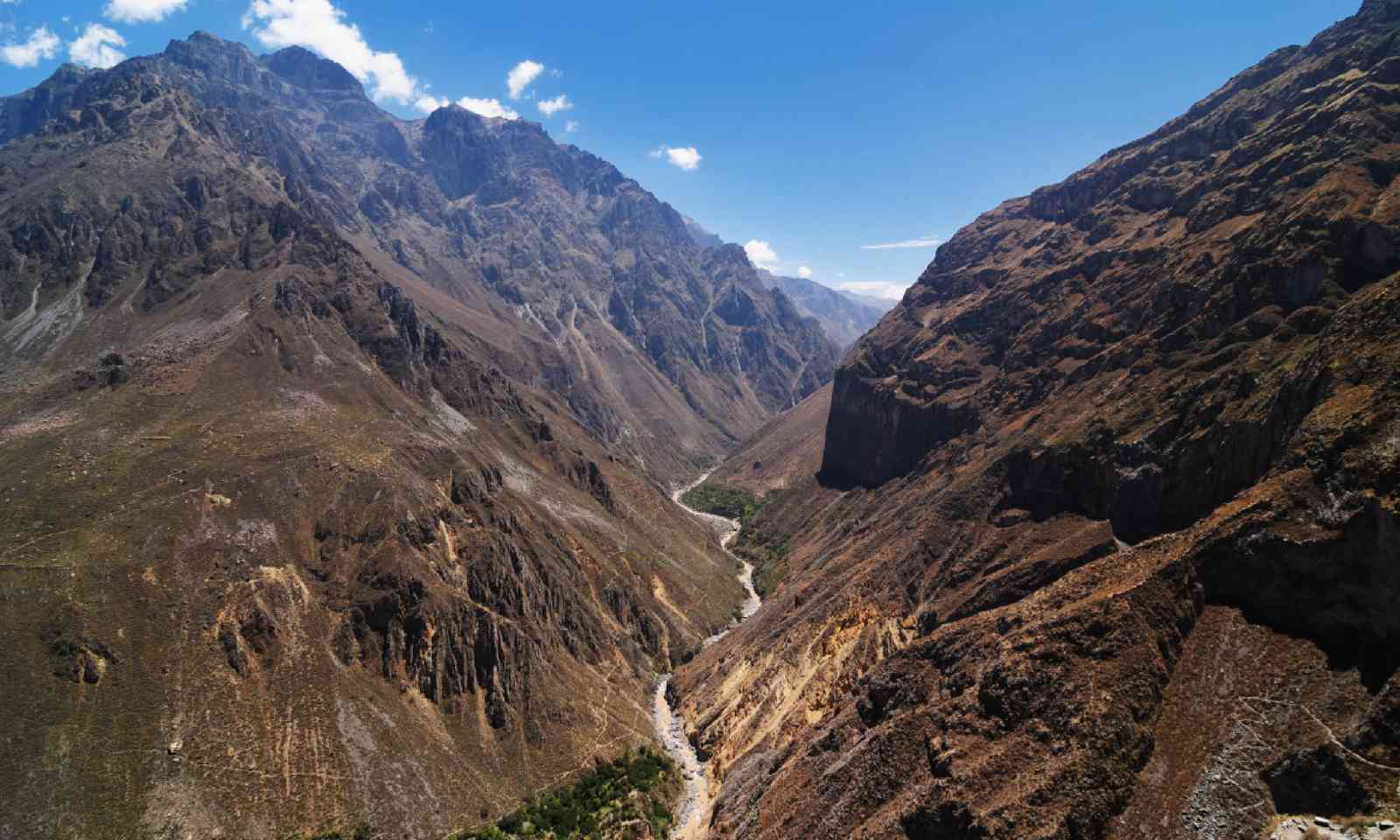
Colca Canyon (Shutterstock)
Turning a corner, we found three more of the birds circling above our heads. One settled into a nest in the cliff face. The other two sped around rocky outcrops. It looked like they were working together, swooping in neat formations. Then one disappeared into the lower reaches of the canyon, while the other climbed 500m to the top, a speck that vanished in cloud. “That was a good moment,” Paul smiled.
We saw three more on the descent to Llahuar Lodge’s riverside bamboo huts, one gliding effortlessly across the canyon in seconds. It’s not only the condors that make this place special. As we hiked up a steep hill the next morning, Paul explained how Colca blows both hot and cold. “Colcas means something like ‘refrigerator’. The canyon has caves in a cold windy area that were good for keeping food like potatoes or maize. But the canyon is also called Valle del Fuego, or Valley of Fire, because of the volcanoes, thermal baths, hot pools, geysers and earthquakes.”
The canyon is so geologically interesting that the government has nominated it to be considered by UNESCO for ‘geopark’ status, awarded to places with ‘geological heritage of international significance’. “It’s a good idea,” Paul agreed. “Colca’s become an important place. The land of volcanoes. The land of animals: vicuñas, Andean foxes, pumas, condors, giant hummingbirds. We have Mismi, the source of the longest river in the world. And the volcanoes.”
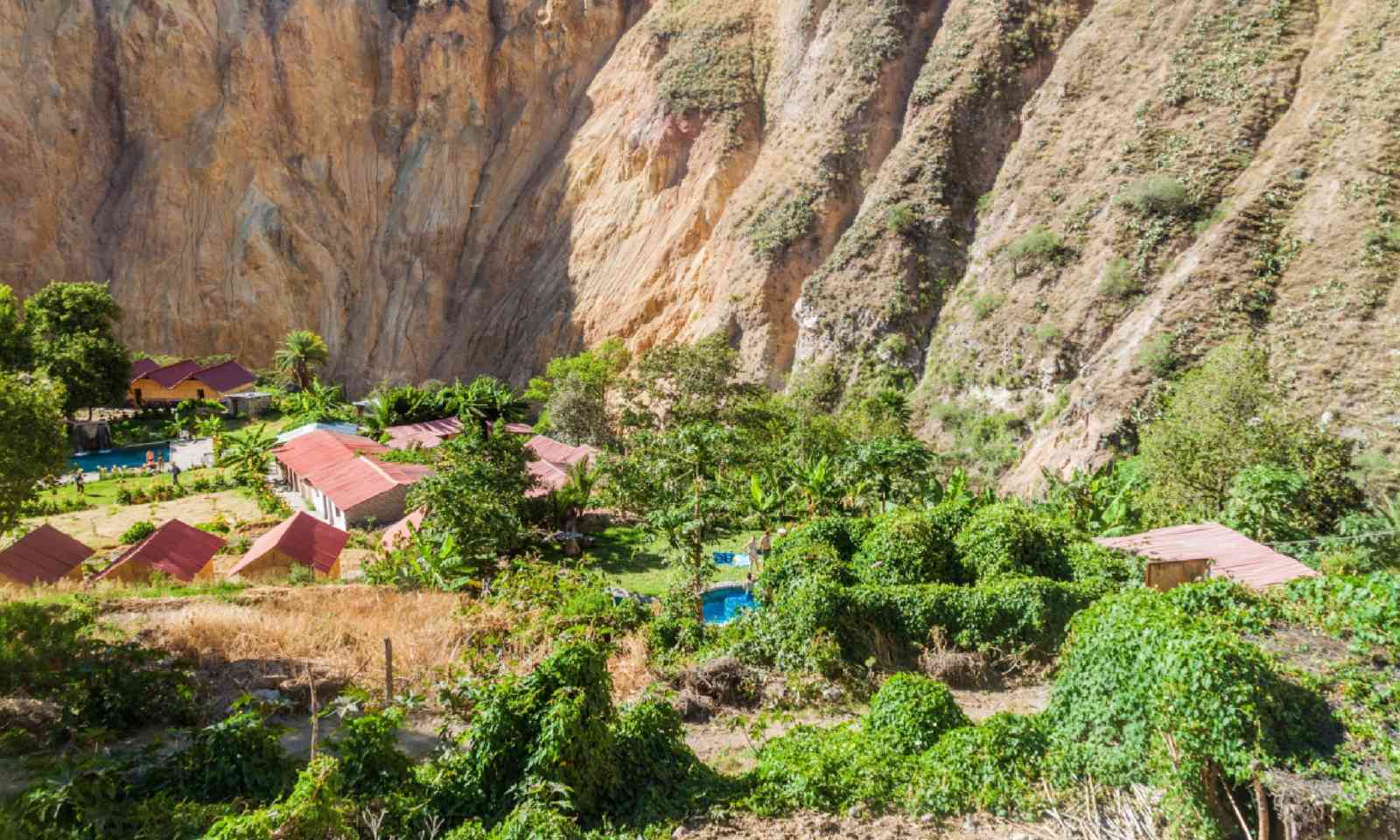
Sangalle oasis (Shutterstock)
We spent the night at the canyon’s green oasis, Sangalle, setting off in chilly darkness the next morning. The moon and stars slowly gave way to sunlight as we made the gruelling three-hour, 1,100m climb back to the top. The condors, though, made getting up and down the canyon look ridiculously easy.
We spotted six of them – juveniles, but giants – rising up the warming canyon as we drove back from Cabanaconde. We pulled over at the roadside and watched them fly for half an hour: the apus, messengers of the gods, the harbingers of death. After perching on rocks to warm in the sun, all six took to the skies again, circling around and above before disappearing off into the cool canyon’s warm depths.
The author travelled with Reef & Rainforest. An 11-day Arequipa, Condors and the Colca Canyon Tour includes international and domestic flights with Iberia and LAN, transfers, breakfasts and some meals, a city tour of Arequipa, condor watching, a three-day trek in the Colca Canyon, mountain-biking and visits to other sites in the region. Trips run April-October. Trips to Mismi can be booked separately through Reef & Rainforest.
All images by Graeme Green, unless otherwise stated. Follow Graeme Green on Instagram (instagram.com/graeme.green/), Twitter (twitter.com/greengraeme) and
Facebook (facebook.com/graeme.green).
Main image: Flying condor over Colca Canyon (Shutterstock)
There was no sign, but Paul Vica, my local Collagua guide, wasn’t worried. “It’s OK. I have the condors’ cellphone,” he told me. “I can call them and they’ll come.” There’s another way to get them here: “If you have a kilo of donkey meat, now is the time to use it,” Paul joked.

With the moon still high in the sky, sunlight filled the valley, warming the air and luring the birds into action. One after another, the Andean condors became visible, circling far below us in the depths of the canyon. I counted six, all large brown juveniles.
They rose up towards the Cruz del Condor viewpoint, riding on the morning’s thermals. We watched as they glided, turned, dived and climbed, soaring above our heads before gradually making their way down the length of the canyon, disappearing out of sight.
The birds are disappearing on a grander, more worrying scale, too. Currently classified as ‘endangered’, Peru’s condor population is declining. Colca Canyon can already boast of being perhaps the second-deepest canyon in the world (the deepest is allegedly in China), more than twice as deep as the Grand Canyon (3,270m or 4,160m deep, depending on who you ask and where they measure from).
But it’s the condors that put it on the map, which is strange, given there are more of the birds in parts of Argentina and Chile. Peru’s condors are a vital part of Andean culture, though – so much so that in 2015 the country’s government announced a National Strategy to protect, conserve and hopefully increase the numbers of condors across Peru.

There are many superstitions: that a good person could be reborn as a condor; that a condor flying over a village means someone there will soon die. “Condors are a sacred creature,” Paul explained. “The people in this area call the condor the apu, which is like ‘god’. They say the condor is a messenger from the other world, the connection between this life and the other life. I see a condor as an animal. But my parents and grandparents say, look, the apu is flying.”
Meeting the ice maiden
Before reaching Colca Canyon, I spent a few days in Arequipa, Peru’s second-biggest city, ringed by mountains and snow-tipped volcanoes, including the still-active Misti.“People think Arequipa is called the White City because of all the white stone,” local guide Patricia Oviedo told me as we walked around downtown’s alleys and plazas of volcanic white sillar. “The real reason is that after the Spanish arrived here in the 1530s and 1540s, the population was 85% white.”
The city has a few other names: Volcano City and Tremble City (because of earthquakes). “It always shakes,” said Patricia. We passed the Mario Vargas Llosa Library, named after the Arequipa-born Nobel prize-winning author, and made our way to Plaza des Armas, which, with fountains and pigeons, felt like the city’s Trafalgar Square.

Plaza in Arequipa (Shutterstock)
Patricia pointed to the tower of the basilica, rebuilt after 2001’s big earthquake. “Arequipeños are very proud, very ‘up’. Many times after earthquakes, the city has suffered and we had to rebuild. It’s a very resilient city.”
The city’s most famous resident (Llosa lives in Lima) is Juanita, a frozen mummy, one of four children whose bodies were discovered on the summit of Ampato volcano in Colca Canyon. All were victims of Inca ritual sacrifices to appease the gods or ask for good crops.
I visited Museo Santuarios Andinos where Juanita’s body is held. The museum is an interesting look into ancient Inca culture, with displays of plates and pots for alcoholic chicha and coca, as well as statues and other offerings. But to see Juanita, cased in glass, knowing her skull was fractured by a blow to the head with a ceremonial rock, felt very sad, an example of the brutal things people do in the name of religion.
Better by bike
I left Arequipa, driving towards Colca Canyon and into a landscape of dry desert, craggy mountains, cacti and high plateaus of long golden grass. We were getting higher all the time, the road climbing gradually from the 2,200m altitude of Arequipa. Golden vicuñas ran across scrubland in front of Misti volcano. Alpacas grazed down in the valley.Further along, a farmer led a troop of llamas along the road, each dressed in bright pink and red ribbons, on their way to a local festival; their faces read ‘mortified’. We could’ve driven right in, but there’s a more fun way to arrive at the Colca Valley.

At the road’s 4,910m highpoint, Miradores de los Volcanes, I met Paul to descend instead by mountain bike. We zipped downhill on a zigzagging trail, avoiding (or trying to avoid) rocks and little bushes. Five minutes in, Paul stopped to show me a green plant. “This is chachacoma, to make tea. It’s better than coca for altitude sickness.”
We raced on, clouds casting shadows over the huge valley. Viscachas (like bushy-tailed rabbits) bolted as we rolled by. The trail joined the road and we sped down curves and switchbacks, our 40km ride taking us to the little town of Chivay and across the town square of Yanque, all the way to Colca Lodge and a hot cup of coca tea.
I drove out early next morning with Paul to Cruz del Condor, the pre-Inca (and still used) agricultural terraces of Colca Valley slowly giving way to the sheer granite walls of Colca Canyon. The condors are big business here, tourists spilling out of buses and vans, locals selling food and postcards.

But not everyone likes the birds. “Some people blamed them for killing their animals,” Paul explained, as we sat on the rocks next to the viewpoint’s cross, “so they killed them with pistols.”
There are other likely reasons for the decline, from habitat destruction and urbanisation to the birds swallowing poison intended for other predators such as pumas. There’s also an Andean ritual that continues in some areas, the Yawar Fiesta (Blood Party), which involves a condor (symbolising the indigenous people) being tied to the back of a bull (symbolising the Spanish), the fight representing Latin America’s historic struggle.
Although the condor is supposed to be victorious and escape, it often dies. The National Strategy will look at all of that, but the first step will be a census in Colca Canyon and other condor areas to find out how many condors there are in the country, with the first figures due in 2016.
“We need to know how many condors there are, how many eggs, how many nests,” said Paul, who’s in favour. “My grandfather says 40 to 50 years ago there were many, many condors in this area. It’s important to protect them so we see more again.”
Even with the crowd and their selfie sticks, watching six of the massive birds soar over the canyon was a powerful experience. One of the world’s heaviest birds, with a wingspan of up to 3.2m, they’re strong but graceful in the air. They crossed in front of the sun and glided over the still-visible moon, before making their way into the warmer, deeper parts of the canyon to search for food.

Condors are a safe bet around the cross. “There are seven nests in the cliffs around the Cruz,” Paul informed me. But there’s another reason they might like it here: I heard multiple reports that animal carcasses are put out across the canyon to keep the birds coming and ensure the survival of the valuable tourist trade, which could be disrupting the birds’ natural behaviour.
As a condor expert I met in Arequipa put it: “Artificial feeding is good for tourists and local businesses, but bad for the environment and for condors.” This might be something looked at as part of the National Strategy. Change could be coming to Cruz del Condor.
Amazon action
In the afternoon, I took a short, colourful hike down from the village of Coporaque back to the lodge, following an old Inca trail now used by locals, with views of Yanque and the valley’s agricultural terraces.Up ahead I could see the snowy peaks of Hualca Hualca and active Sabancaya volcano spewing smoke into the sky. Behind Sabancaya, partially visible, was Ampato, where Juanita’s remains were discovered. Hiking on through fields of tall grass, I came out at a waterfall, the water flowing down from Mismi mountain, the source of the Amazon.

Hiking to the source of the Amazon River (Shutterstock)
It was there that I headed early next morning. Seeing the source of the Amazon River was the draw, but the colourful mountain landscapes and wildlife along the way made the drive. Flamingos stalked small lagoons, alpacas grazed and little grouse-like tinamou scuttled off the road.
“Acclimatisation stop,” Paul announced, as we got out next to a lake busy with ducks, Andean geese and puna ibis.
We drove higher, spotting vicuñas running across a sun-baked plateau, before parking below Mismi’s 5,597m summit. There was snow on the ground; the air was cold and supermodel thin. Paul brewed chachacoma tea, then we hiked around the rocky curve of the mountain.
“This is the official spot, Carhuasanta, the source of the Amazon,” Paul said, pointing at water gushing from cracks in the cliff face. I couldn’t resist filling my bottle and taking a good glug of ‘Amazon source’. There’s a debate here, some saying the Amazon starts in other locations around Mismi or further afield. But for now, this spot has the official sign.
“You can say the longest river in the world starts from Mismi,” Paul told me proudly. “It flows from here, 6,800km, all the way to the Atlantic Ocean in northern Brazil.”
Blowing hot & cold
I ended my trip with a three-day hike down into Colca Canyon, starting from the town of Cabanaconde. Dropping 1,100m in five hours isn’t a walk for the weak of knee, but the giant canyon walls made for an exciting environment. A procession of four adult condors passed us, sailing through the heart of the canyon as we made our way down the cacti-laden slopes.
Colca Canyon (Shutterstock)
Turning a corner, we found three more of the birds circling above our heads. One settled into a nest in the cliff face. The other two sped around rocky outcrops. It looked like they were working together, swooping in neat formations. Then one disappeared into the lower reaches of the canyon, while the other climbed 500m to the top, a speck that vanished in cloud. “That was a good moment,” Paul smiled.
We saw three more on the descent to Llahuar Lodge’s riverside bamboo huts, one gliding effortlessly across the canyon in seconds. It’s not only the condors that make this place special. As we hiked up a steep hill the next morning, Paul explained how Colca blows both hot and cold. “Colcas means something like ‘refrigerator’. The canyon has caves in a cold windy area that were good for keeping food like potatoes or maize. But the canyon is also called Valle del Fuego, or Valley of Fire, because of the volcanoes, thermal baths, hot pools, geysers and earthquakes.”
The canyon is so geologically interesting that the government has nominated it to be considered by UNESCO for ‘geopark’ status, awarded to places with ‘geological heritage of international significance’. “It’s a good idea,” Paul agreed. “Colca’s become an important place. The land of volcanoes. The land of animals: vicuñas, Andean foxes, pumas, condors, giant hummingbirds. We have Mismi, the source of the longest river in the world. And the volcanoes.”

Sangalle oasis (Shutterstock)
We spent the night at the canyon’s green oasis, Sangalle, setting off in chilly darkness the next morning. The moon and stars slowly gave way to sunlight as we made the gruelling three-hour, 1,100m climb back to the top. The condors, though, made getting up and down the canyon look ridiculously easy.
We spotted six of them – juveniles, but giants – rising up the warming canyon as we drove back from Cabanaconde. We pulled over at the roadside and watched them fly for half an hour: the apus, messengers of the gods, the harbingers of death. After perching on rocks to warm in the sun, all six took to the skies again, circling around and above before disappearing off into the cool canyon’s warm depths.
The author travelled with Reef & Rainforest. An 11-day Arequipa, Condors and the Colca Canyon Tour includes international and domestic flights with Iberia and LAN, transfers, breakfasts and some meals, a city tour of Arequipa, condor watching, a three-day trek in the Colca Canyon, mountain-biking and visits to other sites in the region. Trips run April-October. Trips to Mismi can be booked separately through Reef & Rainforest.
All images by Graeme Green, unless otherwise stated. Follow Graeme Green on Instagram (instagram.com/graeme.green/), Twitter (twitter.com/greengraeme) and
Facebook (facebook.com/graeme.green).
Main image: Flying condor over Colca Canyon (Shutterstock)


